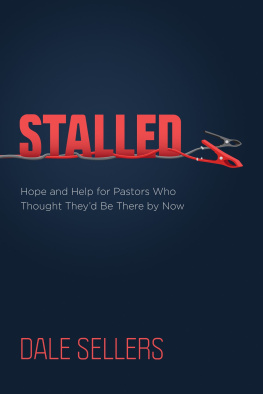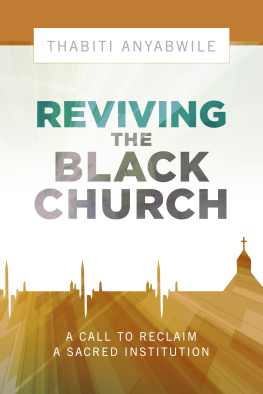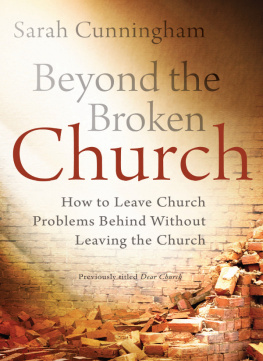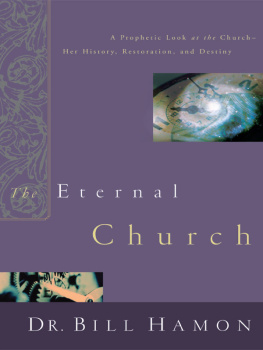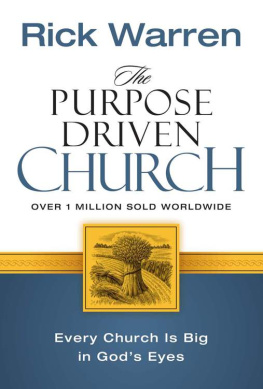CHAPTER
The Church Has Lost Its Vision
W hen the church experiences conflict with its pastor, its leadership, or within the church in general, oftentimes the church loses its vision. This conflict, especially when it occurs within the church leadership, leads to a loss of shared vision. Thus, the church begins to decline because it does not know where it is going.
Vision or a planned direction is essential for any organization. Burt Nanus, in his book Visionary Leadership, writes, There is no more powerful engine driving an organization toward excellence and long-range success than an attractive, worthwhile, achievable vision for the future, widely shared. If the church loses its vision, it loses direction and begins to decline. Church revitalization necessitates the establishment of a renewed vision with which the church can unify.
Vision Defined
Hans Finzel offers an interesting definition of vision, a rather practical statement that not only says what vision is but what it does. He writes, A vision is a picture of the future state for the organization, a description of what it would like to be a number of years from now. It is a dynamic picture of the organization in the future, as seen by its leadership. It is more than a dream or set of hopes, because top management is demonstrably committed to its realization: it is a commitment.Thus, vision sets the direction of the church, giving it purpose, meaning, and a reason for its existence. To discover and communicate this purpose necessitates both a general understanding of the purpose of the body of Christ but also a specific purpose of how one particular church seeks to fulfill that vision within the context of its lifetime.
The Primary Function of the Church (The Big Picture)
In order to get the church back on track when no shared vision exists, the pastor must first lead the church to understand why Jesus created the church. It is a biblical issue at this point. Most Christians know the Great Commission expressed in Matthew. When looking at the end of Jesus ministry here on the earth, one must take into account the last words that He spoke. Last words are important. Jesus took His disciples on a high mountain, one from which much of their known world could be seen. To the north, they could see the tip of the Sea of Galilee. To the east lay the Jordan Valley leading to Perea. Further east were the southern cities of the Decapolis, including Gadara and Gerasa. To the west, the disciples could see parts of Samaria. Finally, to the south, Jerusalem would be visible on a clear day.
Jesus then said to these men, Go, therefore, and make disciples of all nations, baptizing them in the name of the Father and of the Son and of the Holy Spirit, teaching them to observe everything I have commanded you. And remember, I am with you always, to the end of the age (Matt. 28:1920). Jesus makes one command: to make disciples. The process occurs through going, baptizing, and teaching. Those ideas present the one commission Christ gives to the church, a command that is still in effect today.
When a church loses its vision, most probably the trouble traces back to a loss of understanding about the Great Commission. Sometimes it is theological. Previous pastors or laypeople may have failed to teach the real meaning of these words, and they have bought into a substitute purpose for the church. Sometimes the problem is internal. When the church experiences problems and people respond to one another in anger and unforgiveness, they forget about the Great Commission. People overlook those who do not know Christ when they are not in fellowship with one another. Finally, if that reputation spills out into the community, the church will struggle to get anyone interested in listening to its message. The problem moves from theological to internal to pragmatic. Therefore, to get the church back on track:
- Spend time going back to the basics
- Teach and preach on the purpose of the church
- Develop short-term projects or opportunities for the church to experience and fulfill the Great Commission
- Lead the church to practice forgiveness
Ron Jenson and Jim Stephens echo this sentiment:
Rallying the members of a local church around the common objective of making disciples will have enormous implications for the growth of the church. Many churches have lost sight of their purpose. Knowing and understanding the objective gives direction and meaning to all a church does.
An awareness that outreach to the community and the world is central to its existence affects a churchs quantitative growth. When a church sees itself as a base of ministry to those living around it, it will be continually praying and thinking about effective ways to minister to the community. This will be a natural preoccupation because the church exists to minister.
Thus, in order for the church to revitalize, it must renew its commitment to its central function: fulfilling the Great Commission.
What Vision Is Not
Aubrey Malphurs offers assistance in understanding vision by defining what it is and what it is not. In defining vision, he writes:
A Vision Is Not a Dream. The terms may be used synonymously, but, in fact, a dream is much broader than a vision. Often the envisioning process begins with a dream. Dreams initiate or fuel visions.
A Vision Is Not Goals and Objectives. Goals and objectives are cold and abstract things that do not warm the heart. Vision, however, is warm and concrete and has the potential to melt the coldest heart. Just as a dream precedes a vision, so a vision precedes goals and objectives.
A Vision Is Not a Purpose. Most often purpose answers the question, Why? Vision answers the question, What? I argue that the purpose of the church is to glorify God (Rom. 15:6; 1 Cor. 6:20), whereas the mission and vision of the church concern the Great Commission (Matt. 28:1920).
A Vision Is Not a Mission. A ministrys mission is a statement of where it is going; whereas, its vision is a picture or snapshot of the same. Primarily the mission affects planning the organizations future, while the vision affects the communication of that future.
What a Vision Is
Malphurs also explains what comprises a vision. He personally defines vision as a clear and challenging picture of the future of a ministry as you believe that it can and must be. Within the context of this definition, Malphurs clarifies that vision must contain these six facets:
A Vision Is Clear. If the people who make up the ministry do not or cannot understand the vision, then there is no vision regardless of the amount of time spent in developing it.
A Vision Is Challenging. The problem for most ministry visions is that once they are conceived and born, they face a quick, untimely death and are quietly buried in some vision graveyard. If people are not challenged by the vision, there really is no vision.
A Vision Is a Mental Picture. A good vision probes the imagination in such a way that it conjures up visual representations in the mind. John R. W. Stott says of vision, It is an act of seeingan imaginative perception of things, combining insight and foresight.... We see what it isbut do we see what it could be?
A Vision Is the Future of the Ministry. Vision is always cast in terms of the future. It is a mental picture of what tomorrow will look like. Most visions are perpetually in the state of becoming and thus remaining futuristic. These are long-term and open-ended visions.
A Vision Can Be. A good vision has potential. It rests firmly on the bedrock of realitythus it is highly feasible.
A Vision Must Be. A good vision grabs hold and will not let go. Several factors contribute to this conviction:
Next page

